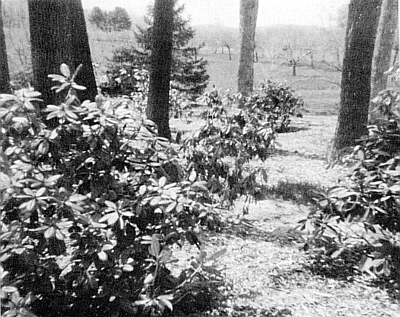QBARS - v30n3 Skylands
Skylands
Bill Klippel, Upper Saddle River, New Jersey

|
|---|
Gift of several hundred specimen plants gave the rhododendron display garden at Skylands a head start. |
The Tappan Zee Chapter of the American Rhododendron Society is lucky to have been located near a rather new and very promising botanical garden. This installation, known as Skylands Gardens, is part of the Ringwood Park System, of the State of New Jersey. It is located in the Ramapo mountains of Northern New Jersey just west of Suffern, New York.
Originally Skylands was the private estate of Clarence MacKenzie Lewis and was only acquired by the New Jersey Park Systems in 1966. Mr. Lewis' avocation was horticulture, and on his 1,165 acre estate he, during the period of 1923 to 1954, accumulated one of the larger collections of native American flora existing on the East Coast. Mature plantings of such trees as Kentucky Coffee ( Gymnocladus dioicus) , Yellow Wood ( Cladrastis lutea ), Cucumber Magnolia ( M. acuminata ), Umbrella Magnolia ( M. tripetala) , Big Leaf Magnolia ( M. macrophylla ), Jeffrey Pine ( P. jeffreyi ), and Bald Cypress ( Taxodium distichum) are in prominent display. Also present are such trees as Sweet Bay Magnolia ( M. virginiana ), Silver Bells ( Halesia monticola ), and Sour Wood ( Oxydendrum arboreum ) which are suitable for small lot plantings, but unfortunately not widely used. The native species of trees, plants, etc., are generously sprinkled with the required amount of imported rarities. Generally, landscaping of the grounds lend an eye to a natural, as opposed to formal, arrangement. It is obvious Mr. Lewis' intent was to blend his estate into the naturalistic surroundings of the Ramapo Mountains with minimum discord.
Many of the genera of plants are located so that the various species are within view of each other to allow visual comparison. This lends itself well as a teaching garden to those interested in botany.
Mr. Lewis' original plantings of rhododendrons had not been well cared for by interim owners of the estate, so that this particular genus was not well represented. It therefore became evident to various members of the Tappan Zee Chapter that a proper display garden of ericaceous plants was much in need. Working in conjunction with park personnel, we selected a spot under tall oak trees, which we felt was ideally suited for these plants. A garden was designed to fit in with Lewis' original intent, controlled nature.
About the time this program got off the ground, two active members of the American Rhododendron Society, Dick and Herb Redfield, decided to move from their Closter, New Jersey, home to central Connecticut. It was basically through their generous donation of several hundred specimen plants that we were able to put together an almost instant display garden. In addition to the Redfields' and the Tappan Zee Chapter's donations, we have acquired a large collection of kalmias, representative of the efforts of Dr. Richard Jayne of the Connecticut Experimental Station.
Robert Gartrell of Wyckoff, New Jersey, has, as many realize, developed some extraordinarily good azalea hybrids, employing Satsukis and a hardy form of R. kaempferi .
The fifty selected plants, named by Mr. Gartrell as Robin Hill Hybrids, will shortly be on display. In the near future we will include representatives of all of the American Rhododendron species hardy in our area, and the various hybrids in the deciduous group, such as Knaphills, Exburys, Mollis, and Ilams.
So far we have planted approximately one half to three quarters of an acre. Our garden plans cover approximately two acres; however, park supervisory personnel have generously suggested that, if we should wish to continue up the side of Mount Defiance, they would not be opposed.
We are quite pleased with our efforts and feel that the public's response, to date, has more than offset the expense and physical labor involved. One aspect of the garden frequently receiving praise is the fact that it is not totally rhododendrons. We have carefully under planted, and over planted, with companion plants attempting to develop variations in leaf texture and color, so that the gardens take on a pleasing aspect even when the major flower display has long since passed. Some under plantings contemplated or presently used with success are, Corydalis lutea , C. sempervirens , Aquilegia canadensis , A. flabulata nana , cyclamens and gingers. Various ferns have been found excellent for texture, and blood-root and trilliums for early spring bloom.
Our efforts are just beginning; however, they are, even at this early date, well worth an examination. So we would invite any members of the rhododendron community to pay Skylands a visit in the near future.

